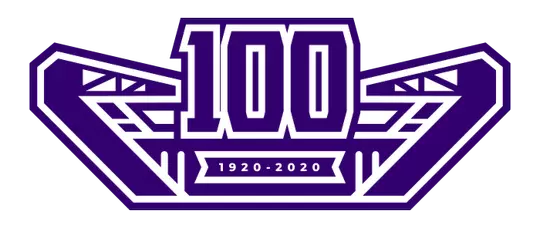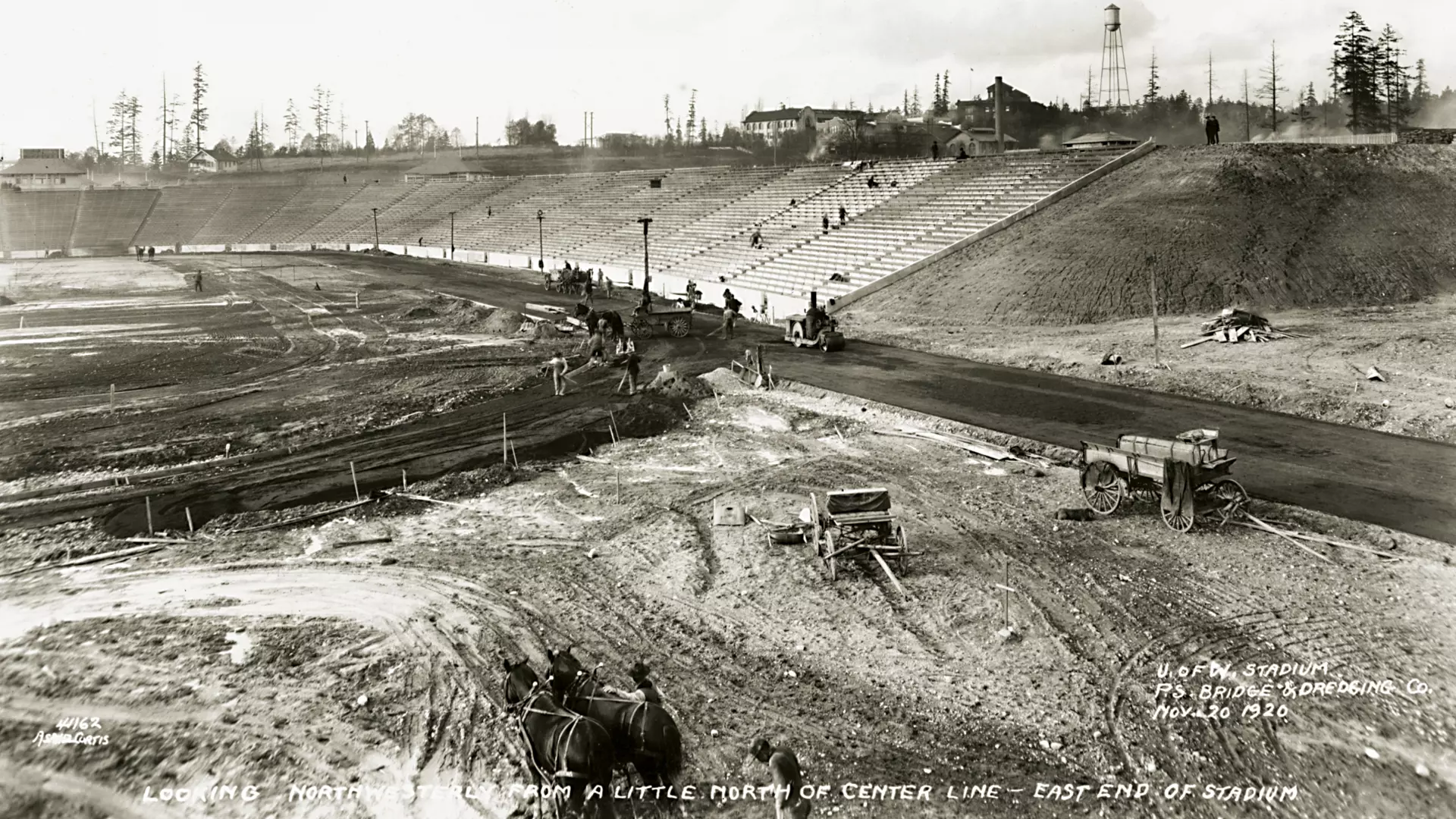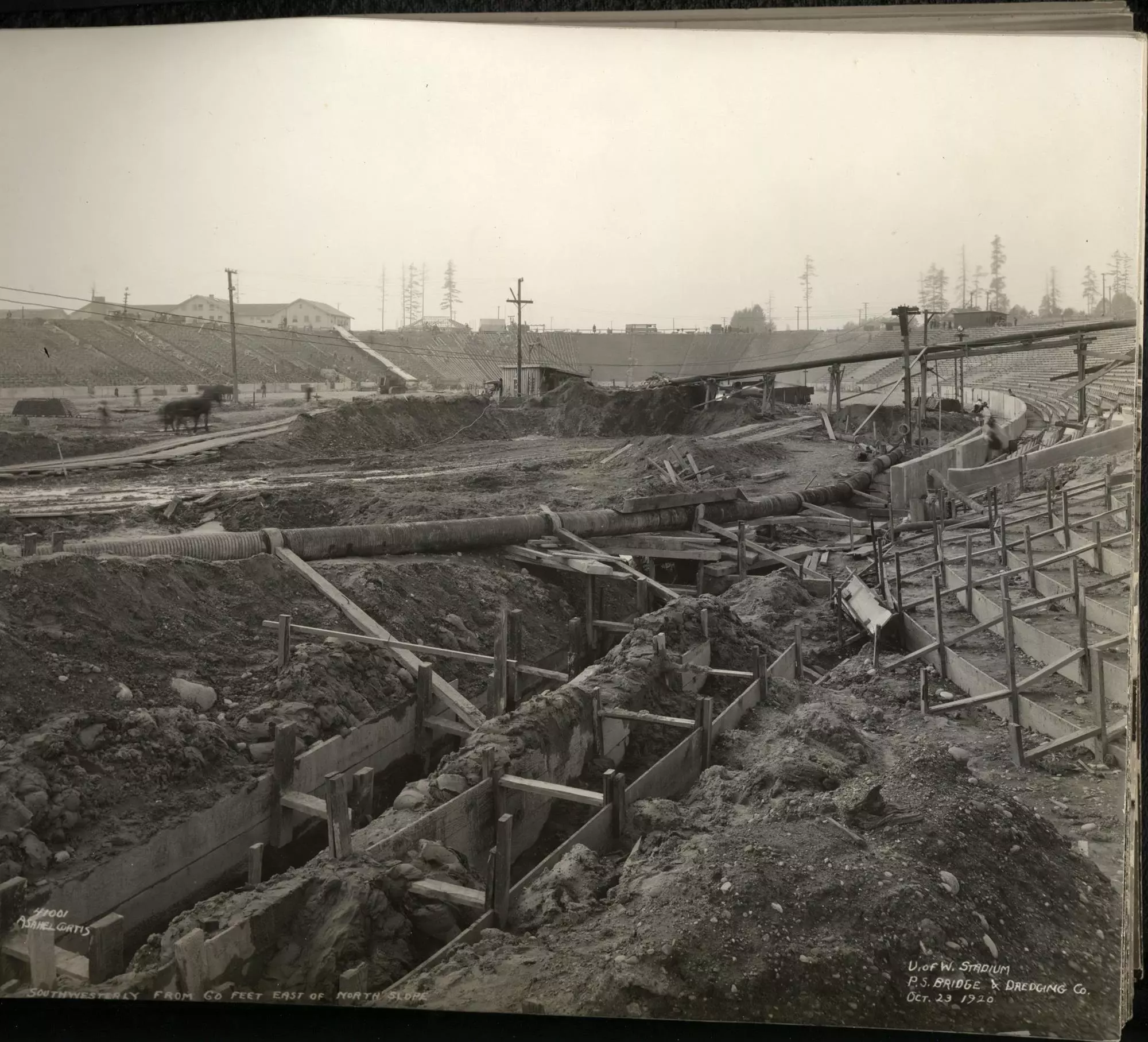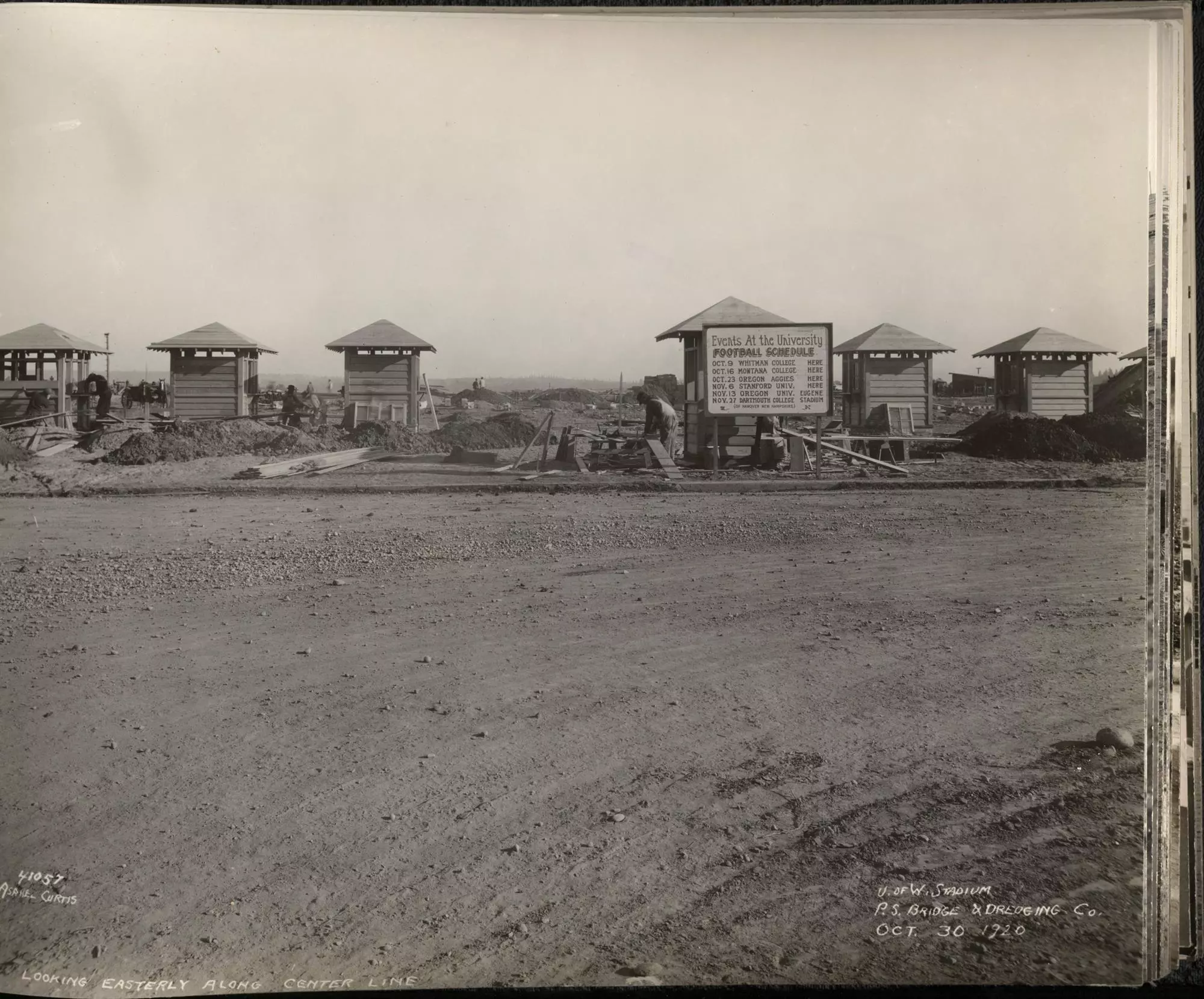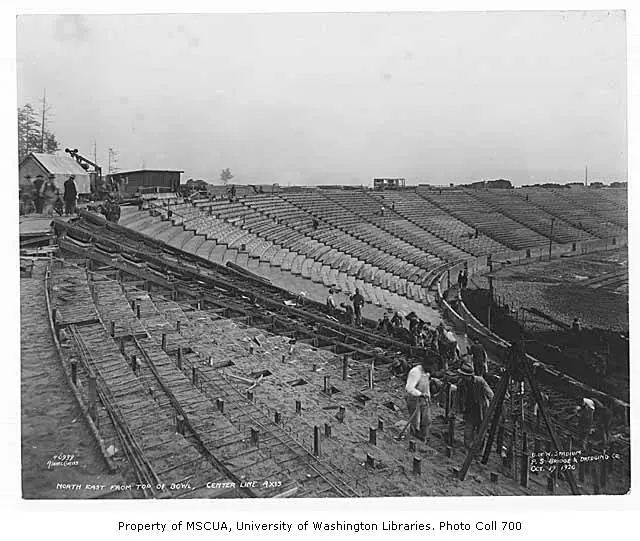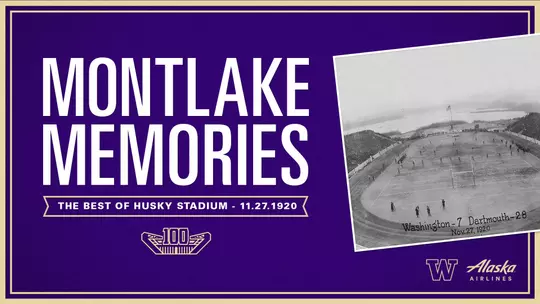
Montlake Memories: November 27, 1920
Husky Stadium Centennial Celebration
Jeff Bechthold
10/5/2020
A broad series of events over the course of 25 years converged to bring about the building of the University of Washington's new stadium, which was christened in the final game of the 1920 season as the Huskies played host to Dartmouth, on Nov. 27, the Saturday after Thanksgiving.
Two and a half decades earlier, in 1895, the UW relocated its campus from downtown Seattle to its present location on the shores of Lake Washington. Years later, prior to World War I, the long-planned construction of the Lake Washington Ship Canal, which would connect Lake Washington to Puget Sound, began, with the Montlake Cut officially opening in 1917.
That massive endeavor spawned a land reclamation project on the eastern portion of the UW campus, from the mouth of the Cut to Laurelhurst. With the new canals lowering the water level of Lake Washington, and with the tons of dirt that were dug to create the Cut, the land where most of the UW athletic facilities now sit was created, or "reclaimed" from the lake. The original, horseshoe-shaped berm for the stadium itself was formed from earth dredged to create the Cut.
Since moving the campus from downtown, the UW had played its games at Denny Field near Northeast 45th Street and 20th Avenue, between the current locations of Hutchinson and Madrona Halls. But the team was about to outgrow that venue.
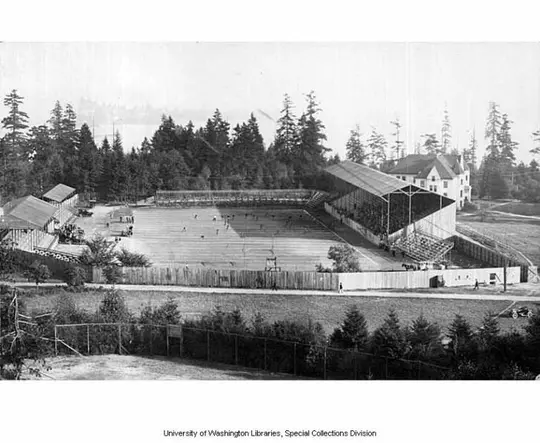
In the final game of the 1919 season vs. California, "A Thanksgiving Day throng of nearly 20,000 – by far the largest crowd in Northwest football history – saw the purple and gold humble the champions of the South in the season's gridiron classic, 7 points to 0," Royal Brougham wrote in the Seattle Post-Intelligencer. While the crowd was large by the standards of the time, the UW and athletic director Darwin Meisnest actually turned away many more fans, thus losing out on a much larger payday. It was then that the drive to build a new stadium began in earnest.
Almost exactly a year later, Meisnest had teamed with the ASUW, the city, the University and the state to not only plan a new stadium, but to raise the needed funds and complete the actual construction. On Nov. 27, 1920, the new "University of Washington Stadium" made its debut. It took merely six months to construct and was hailed as the finest sporting venue in the west.
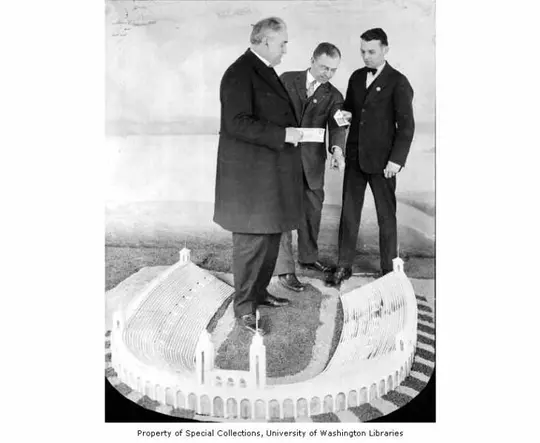
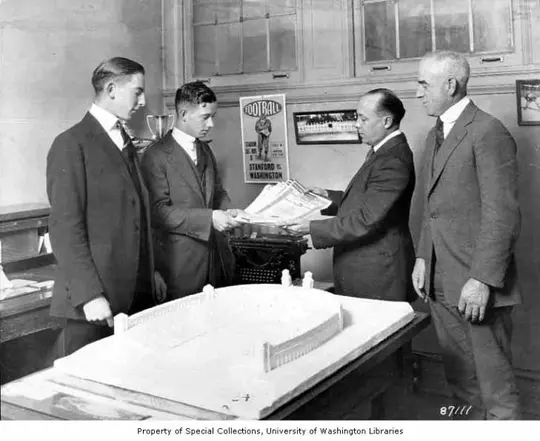
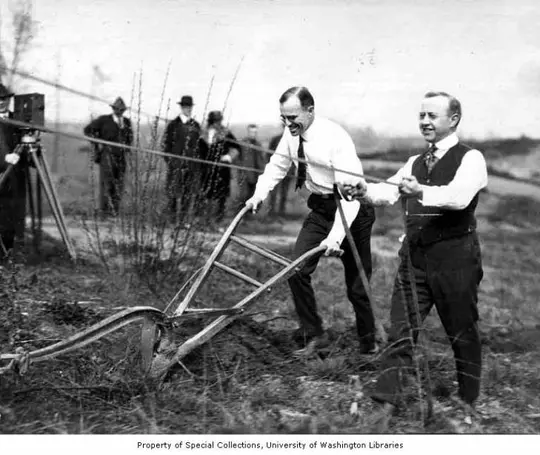
Dignitaries for the stadium's opening included Governor Louis F. Hart and Lieutenant Governor-elect William "Wee" Coyle, who had quarterbacked the UW to four straight undefeated seasons a decade earlier and become one of Seattle's first sports celebrities.
While the ceremonies, which also included members of the earliest UW football teams along with office-holders and high-ranking officials from the University, the city, the state and the United States military, went off without a hitch, the visitors from the Ivy League proved too much for the Sun Dodgers, as the Washington team had recently been dubbed.
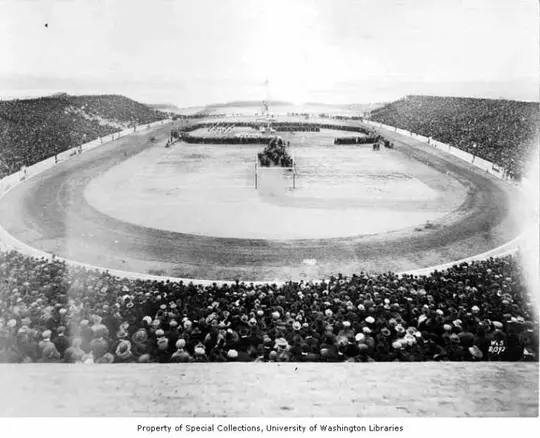
Here is the first portion of Royal Brougham's recap in the following day's Seattle P-I:
"The mighty eleven of Dartmouth College, bearing the standard of the East, triumphed over the West, yesterday, when a Washington team bowed in defeat before an aerial attack the likes of which was never before witnessed in local football history. Twenty-eight points to seven–four touchdowns to one–was the result of the epochal struggle fought in Seattle's new athletic field, when the largest crowd in Northwest football history saw the wearers of the green forward-pass their way to a rightly-earned win.
"The phenomenal passing game of the Hanover men, that and that alone, spelled the defeat of Washington. Through two spectacular quarters the Dodger squad thrilled its supporters by fighting the invaders to a standstill. Honors were even at the close of the first half, each eleven scoring a touchdown and converting. Quarterback Abel blocking a kick, recovering and sprinting fifty yards for a touchdown and the first score of the contest.
"But the second half was a vastly different and sadder story. Coach Spears gave the signal for the open work to begin. With Captain Jim Robertson, the All-American backfield man of Dartmouth, lobbing the football like Ty Cobb throwing baseballs, the crowd was treated to a dazzling display of passing which electrified the spectators and bewildered the Washington secondary defense. Long passes and short passes, low, bullet-like lobs and long spirals which soared half the length of the field was the assortment which the Dartmouth quarterback served at regular intervals, and too often the passes settled into the waiting arms of Green-jerseyed athletes from the New England Coast."
Along with the game action, the P-I also reported on the pageantry. Among other scenes, the newspaper detailed one as follows: "One of the most spectacular features was the giant ‘W,’ in the University colors, purple and gold, formed by the hats of the students in one section. As the University band played, the students making up the huge letter swayed from side to side with the music, creating an effect that was at once exotic and uncanny."
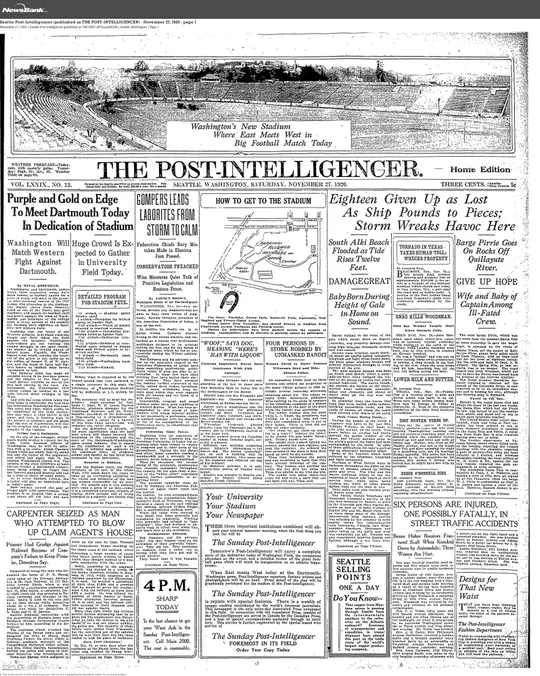
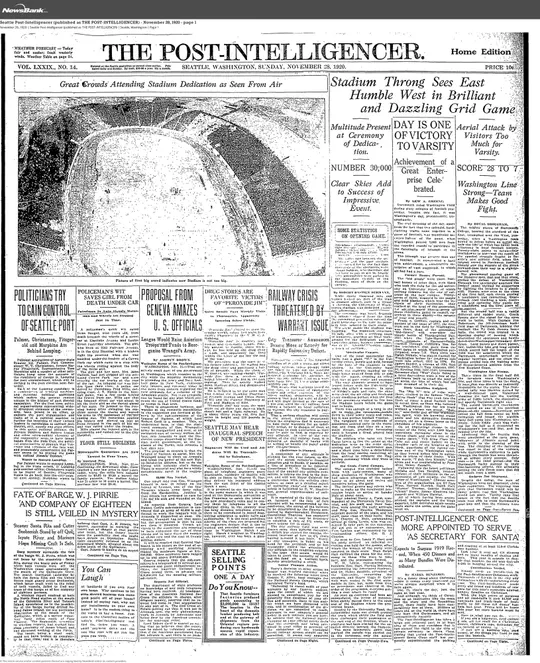
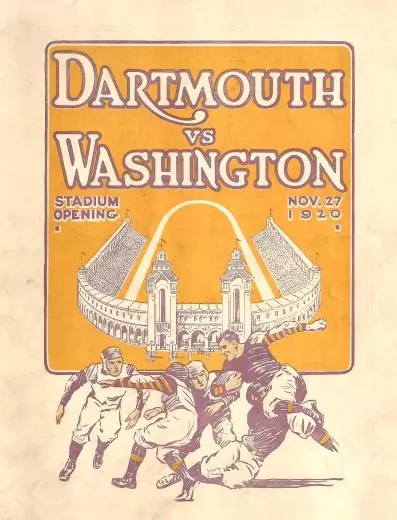
Despite the 28-7 loss, news coverage was unanimous that the opening had gone off flawlessly and that the new stadium was a wonder. Even the late-autumn weather cooperated. The Seattle Times reported, "Although Washington was beaten, which carried a certain regret, the dedication of the huge stadium was the success that graduates, students and citizens alike had hoped. The day, following a night of storm, was perfect. The field was hard and dry, a tribute to the $42,000 drainage system which had been installed."
The Times' reports on the game, which included a society column and provided a crowd estimate of 28,000, included other highlights, noting, "Automobiles to the number of 4,500, according to traffic officers furnished by the Police Department, were successfully handled by students and downtown policemen at the dedication of the stadium yesterday."
The Times also described a sign posted at the main, west entrance of the new facility: "The stadium is a Pacific Northwest product, designed by Washington architects, constructed by Washington men out of Washington materials. Buy Pacific Northwest products."
The stadium-opening game was the last at the UW for head coach Leonard "Stub" Allison, as the team finished with a 1-5 record just four years removed from a nine-year stretch in which Washington didn't lose a single game (1908-1916).
Allison went on to become head coach at South Dakota (1922-26) and California (1935-44). On Jan. 1, 1938, he led the Bears to a 13-0 victory over Alabama in the Rose Bowl, a key highlight in a career that culminated with induction into the California Athletics Hall of Fame in 1977.
Allison was replaced at Washington by Enoch Bagshaw, a Welsh-born former UW football player and World War I veteran who would go on to compile a record of 63-22-6 over his nine seasons (1921-29) before dying in 1930, at the age of 46 years old, having resigned as coach at the end of the '29 season.
Washington's 1920 varsity roster included Olympian Gus Pope, who had just a few months earlier, in August, won the bronze medal in the discus at the 1920 Olympic Games in Antwerp. He went on to take fourth in the discus four years later in Paris, and was the 1921 NCAA champion in both the shot put and discus.
Another star was Ray Eckmann, a two-time team captain (1921 and 1922) who went on to become his alma mater's athletic director and a Seattle City Councilman. He was inducted into the Husky Hall of Fame in 1982.
Robert Abel, who also happened to have served as chairman of the Student Building Committee for the new stadium as well as student body president, appropriately etched his name in history as the first player ever to score a touchdown at what is now Husky Stadium. Abel, who had begun his academic career at UW in 1915 before leaving to fight in World War I, recovered a blocked field goal and ran it back 63 yards (the number of yards is listed differently in different sources) for the UW's only score vs. Dartmouth.
The Seattle Times carried the following description from Abel himself: "I was playing defensive right end. Robertson stepped back to kick. When the ball was snapped back I slipped by the secondary defense and ran down the 'kicking lane' directly at him. When he kicked I couldn't have been more than a yard from him. The ball struck my chest and rebounded. I heard [Elbert] Harper right behind me yelling, 'Pick it up and run!' I scooped it up on the bounce and took it across the line. Somebody put Robertson out of the play. I guess it was Harper."
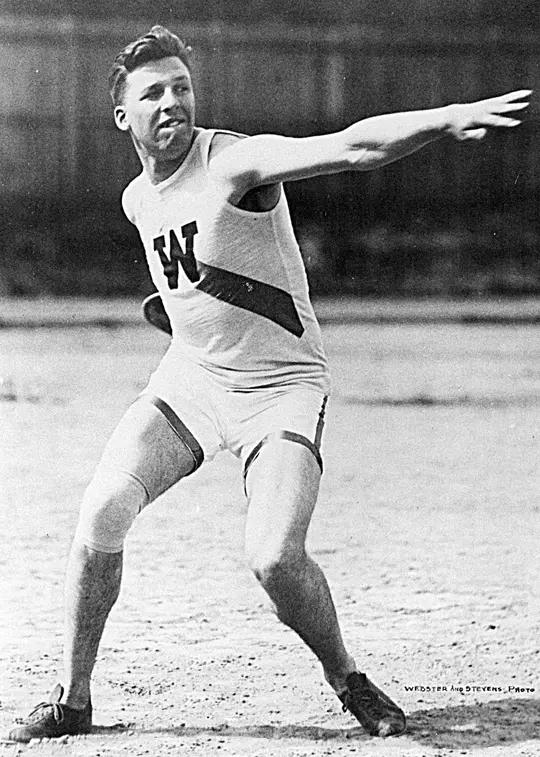
And while he didn't earn a varsity letter until the following season, Washington's 1920 roster also included Hamilton Greene, a law student from Seattle who holds the distinction of being the first Black player in UW football history.
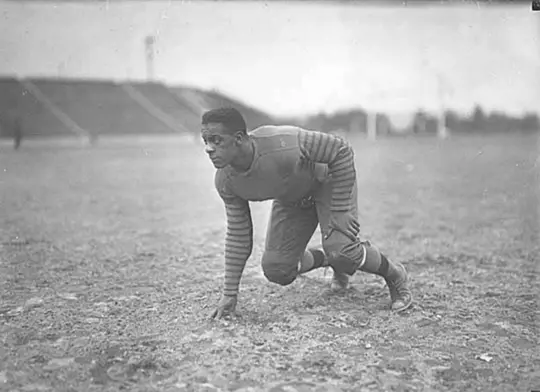
Over the course of the coming weeks, GoHuskies.com will examine the 100-year history of Husky Stadium by taking a decade-by-decade look at the various events – football games and otherwise – that have taken place at the Greatest Setting in College Football. Up next is a look at the 1920s, when several of the most historically significant moments outside of athletics took place at the stadium.

